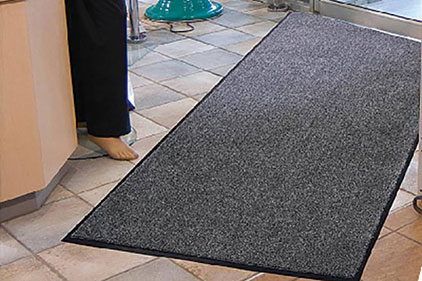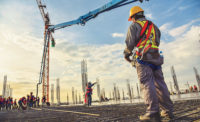Anyone who has had the opportunity to tour Ernest Hemingway’s house outside of Havana, Cuba, will find that the author’s work area was not the typical office. One of the most noteworthy differences is the absence of a traditional desk. For years, Hemingway essentially placed his portable typewriter atop a bookcase so he could stand up as he typed. That’s how he liked to work.
Hemingway was not the first person to find working while standing more productive. Thomas Jefferson is famous for working at a stand-up desk, which he referred to as his “tall desk.” And Winston Churchill invariably worked at an upright desk, which allowed him to stand as he reviewed his paperwork. These luminaries preferred to stand at work because they found they could concentrate better, and it helped get their creative juices flowing.
Benefits of being on your feet
For most of us, sitting at our workstations – either in offices or on the industrial floor – has been the way we have worked for decades. Yet that appears to be changing, especially in the past decade. Standing desks made by a variety of manufacturers are now “in” in the modern workplace, especially in high-tech and more entrepreneurial companies. For instance, the 650 employees of HubSpot, a marketing and software company based in Cambridge, Mass., now have standing desks, which can also be adjusted for sitting.
Not only do these companies feel standing has helped stimulate the creative juices of their staff, but many workers have been sold on standing workstations because of studies that have found sitting for nine to 14 hours a day has the potential to cause a number of health ills. In fact, a new term – sitting disease – has emerged to identify this problem.
And research appears to confirm that sitting disease is real. A Harvard study released in February 2014, which involved 92,000 women, found the more time these women spent sitting at work and at home, the greater their risk of dying of heart disease, cancer or stroke. And another study released in May 2014 involving nearly 17,000 Canadian adults found those who reported the most standing time at work had a 33 percent lower risk of dying from any cause over 12 years compared to those who spent the majority of their time sitting.
On top of health-related issues that might be caused by sitting, many Americans have turned to standing as a way to lose weight. Some studies report standing can burn 20 to 50 more calories per hour, depending on the worker’s size. This is significant when it comes to weight loss, because burning this amount of calories on a regular basis can amount to a loss of as much as eight to 20 pounds per working year. Not only are standing workers happy that they may be losing weight, but many report an overall mood boost when they stand at work, increased energy (which may also contribute to weight loss), and overall less fatigue.*
|
Standing health concerns
While there may be benefits to standing at work, prolonged standing can create an entirely new set of problems for employers and workers. These can include work-related musculoskeletal disorders (MSDs) affecting the legs, knees and lower back, as well as damaged joints, foot pain and serious circulatory problems. This is especially important for employers to realize, because if more workers indicate they prefer to stand while they work, employers will need to take steps to help prevent these potential standing health problems from developing.
Alleviate ailments with anti-fatigue mats
Experts say many of these MSD-related ailments can be alleviated through the use of anti-fatigue mats. Some form of anti-fatigue matting has been around for decades. However, a recently introduced vinyl foam material has helped improve the performance of anti-fatigue mats and reduce the potential health risks of prolonged standing at work.
Anti-fatigue matting systems may look similar to conventional matting systems typically found inside and outside building entries, but they have unique features and characteristics that set them apart. Specifically, they are engineered to provide both a cushion and a bounce when stood on and walked upon. This combination of cushion and bounce helps increase body movement, disperses the worker’s weight more evenly over the surface, and helps improve blood flow and circulation, all helping to reduce injury and fatigue and improve worker productivity.
To illustrate how beneficial these mats can be, a study was conducted by the Center for Ergonomics at the University of Michigan about 10 years ago. In that study, carried out at a major automobile factory, 14 factory workers were selected and asked to perform their duties standing on different types of floor surfaces and conditions — from concrete to an anti-fatigue matting system.
The results: Workers who stood on the hard concrete floors during their work shift reported significant levels of fatigue and discomfort in the legs, back and throughout the body, which is enough to potentially impact worker productivity and production. On the other hand, those workers who stood on the anti-fatigue mats reported 50 percent less fatigue and discomfort, minimizing or eliminating these problems.
Protecting your staff
In addition to the use and installation of anti-fatigue matting systems, employers with standing employees need to encourage workers to take steps on their own so they can take advantage of the potential benefits of standing at work without harming their health. Among the steps some experts suggest are the following:
• Limit continuous standing to about one hour per day and cumulative standing to about four hours per day
• Limit continuous sitting to no more than four hours per day
• Promote variations between sitting and standing positions
• When standing, avoid being totally static and encourage some active movement
• If pain develops while standing, especially lower ligament pain, sit down and report the problem to your employer
Employers will likely want to accommodate the growing number of workers who want to stand at work. But employers must also inform workers of the potential problems that can arise and install adequate matting under workstations to help prevent or minimize these problems.
*While most studies do indicate we burn more calories when standing at work, the amount we burn can vary significantly depending on many factors. Further, some studies report the amount of extra calories burned by standing at work can vary.


